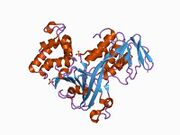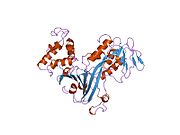Biology:GDI1
 Generic protein structure example |
Rab GDP dissociation inhibitor alpha is a protein that in humans is encoded by the GDI1 gene.[1][2]
Function
GDP dissociation inhibitors are proteins that regulate the GDP-GTP exchange reaction of members of the rab family, small GTP-binding proteins of the ras superfamily, that are involved in vesicular trafficking of molecules between cellular organelles. GDIs slow the rate of dissociation of GDP from rab proteins and release GDP from membrane-bound rabs. GDI1 is expressed primarily in neural and sensory tissues. Mutations in GDI1 have been linked to X-linked nonspecific mental retardation.[3]
Rab GTPases cycles between the cytosolic compartment, where it is bound to a protein called GDI (GDP Dissociation Inhibitor), and the membrane, where it interacts with a receptor, a nucleotide exchange factor, a GAP (GTPase Activating Protein) and probably other factors that link it to the appropriate SNARE. GDI is non-specific with respect to the rab it binds. However, the exchanger, receptor and GAP, are rab specific.
Interactions
GDI1 has been shown to interact with CDC42.[4]
References
- ↑ "Expression patterns of two human genes coding for different rab GDP-dissociation inhibitors (GDIs), extremely conserved proteins involved in cellular transport". Hum. Mol. Genet. 4 (4): 701–8. Sep 1995. doi:10.1093/hmg/4.4.701. PMID 7543319.
- ↑ "Evolutionary conservation and genomic organization of XAP-4, an Xq28 located gene coding for a human rab GDP-dissociation inhibitor (GDI)". Mammalian Genome 5 (10): 633–9. October 1994. doi:10.1007/BF00411459. PMID 7849400.
- ↑ "Entrez Gene: GDI1 GDP dissociation inhibitor 1". https://www.ncbi.nlm.nih.gov/sites/entrez?Db=gene&Cmd=ShowDetailView&TermToSearch=2664.
- ↑ "RhoGDI-binding-defective mutant of Cdc42Hs targets to membranes and activates filopodia formation but does not cycle with the cytosol of mammalian cells". Biochem. J. 359 (Pt 2): 285–94. Oct 2001. doi:10.1042/0264-6021:3590285. PMID 11583574.
Further reading
- "New insights into potential functions for the protein 4.1 superfamily of proteins in kidney epithelium". Front. Biosci. 11: 1646–66. 2006. doi:10.2741/1911. PMID 16368544. https://digital.library.unt.edu/ark:/67531/metadc892527/.
- "Microsequences of 145 proteins recorded in the two-dimensional gel protein database of normal human epidermal keratinocytes". Electrophoresis 13 (12): 960–9. 1992. doi:10.1002/elps.11501301199. PMID 1286667.
- "Molecular cloning and characterization of a novel type of regulatory protein (GDI) for smg p25A, a ras p21-like GTP-binding protein". Mol. Cell. Biol. 10 (8): 4116–22. 1990. doi:10.1128/mcb.10.8.4116. PMID 2115118.
- "Cloning, characterization, and expression of a novel GDP dissociation inhibitor isoform from skeletal muscle". Mol. Cell. Biol. 14 (5): 3459–68. 1994. doi:10.1128/mcb.14.5.3459. PMID 7513052.
- "Cloning of a brain-type isoform of human Rab GDI and its expression in human neuroblastoma cell lines and tumor specimens". Cancer Res. 55 (22): 5445–50. 1995. PMID 7585614.
- "Quantitative analysis of the interactions between prenyl Rab9, GDP dissociation inhibitor-alpha, and guanine nucleotides". J. Biol. Chem. 270 (19): 11085–90. 1995. doi:10.1074/jbc.270.19.11085. PMID 7744738.
- "Determination of structural requirements for the interaction of Rab6 with RabGDI and Rab geranylgeranyltransferase". J. Biol. Chem. 269 (18): 13637–43. 1994. doi:10.1016/S0021-9258(17)36877-1. PMID 8175798.
- "Construction of a transcription map of a 300 kb region around the human G6PD locus by direct cDNA selection". Hum. Mol. Genet. 2 (11): 1865–9. 1993. doi:10.1093/hmg/2.11.1865. PMID 8281148.
- "A novel role for RhoGDI as an inhibitor of GAP proteins". EMBO J. 12 (5): 1915–21. 1993. doi:10.1002/j.1460-2075.1993.tb05840.x. PMID 8491184.
- "Long-range sequence analysis in Xq28: thirteen known and six candidate genes in 219.4 kb of high GC DNA between the RCP/GCP and G6PD loci". Hum. Mol. Genet. 5 (5): 659–68. 1996. doi:10.1093/hmg/5.5.659. PMID 8733135.
- "A gene for nonspecific X-linked mental retardation (MRX41) is located in the distal segment of Xq28". Am. J. Med. Genet. 64 (1): 131–3. 1996. doi:10.1002/(SICI)1096-8628(19960712)64:1<131::AID-AJMG22>3.0.CO;2-N. PMID 8826463.
- "Prenylation of a Rab1B mutant with altered GTPase activity is impaired in cell-free systems but not in intact mammalian cells". Biochem. J. 318 (3): 1007–14. 1996. doi:10.1042/bj3181007. PMID 8836150.
- "A gene for dominant nonspecific X-linked mental retardation is located in Xq28". Am. J. Hum. Genet. 60 (4): 903–9. 1997. PMID 9106537.
- "Differential properties of D4/LyGDI versus RhoGDI: phosphorylation and rho GTPase selectivity". FEBS Lett. 422 (2): 269–73. 1998. doi:10.1016/S0014-5793(98)00020-9. PMID 9490022.
- "Mutations in GDI1 are responsible for X-linked non-specific mental retardation". Nat. Genet. 19 (2): 134–9. 1998. doi:10.1038/487. PMID 9620768.
- "Non-specific X-linked semidominant mental retardation by mutations in a Rab GDP-dissociation inhibitor". Hum. Mol. Genet. 7 (8): 1311–5. 1998. doi:10.1093/hmg/7.8.1311. PMID 9668174.
- "Evaluation of two X chromosomal candidate genes for Rett syndrome: glutamate dehydrogenase-2 (GLUD2) and rab GDP-dissociation inhibitor (GDI1)". Am. J. Med. Genet. 78 (2): 169–72. 1998. doi:10.1002/(SICI)1096-8628(19980630)78:2<169::AID-AJMG14>3.0.CO;2-L. PMID 9674910.
- "PRA1 inhibits the extraction of membrane-bound rab GTPase by GDI1". J. Biol. Chem. 275 (24): 18511–9. 2000. doi:10.1074/jbc.M909309199. PMID 10751420.




